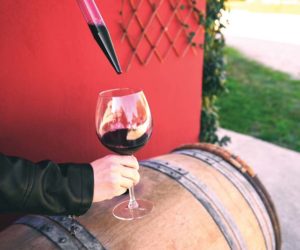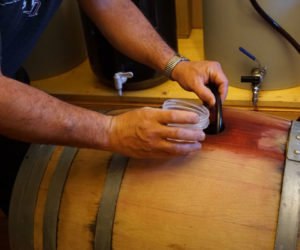
Q
I have made 2.5-gallon batches of pin cherry wine. Without a recipe to go by, I used my old standby: Chokecherry recipe of 20 plus years. It makes excellent wine with a little almond flavor. The recipe calls for crushing/grinding the berries using a three-point grinder. The wine has a bitter/tart taste. Is there any way to remove this, short of pouring it down the drain?
Peter Daellenbach
Roscommon, Mich.
A
Stop right there! Don’t pour your wine down the drain. Your problem is both curable, and most important for future batches, preventable. It seems you’ve got an overload of tannins in your wine, the bitter and astringent compounds found in the skins and seeds of all fruits and vegetables. Usually these compounds add a nice “bite” of astringency to wine, but too much can be a bad thing, as you’ve obviously found out.
Your problem can be prevented by pressing your fruit more gently, either with a basket press (available in most home winemaking stores) or by hand with a large sieve and a stirring spoon, depending upon the volume that you’re dealing with. The key operating concept here is “gentle.” By cranking the seeds and skins of your wine through a grinder, you’re extracting way too much of the bitter seed and skin tannins from the fruit into the wine.
With your current batch, you’ll be able to get rid of some of those tannins by taking your wine through a process called “fining,” which involves adding a “fining agent” that attracts tannins to them and will pull them out of solution and settle them to the bottom of your container. Two fining agents I suggest you try (one or the other) are egg whites (albumen) and PVPP (stands for Polyvinyl Polypyrrolidone).
Albumen is one of the oldest and most widely used fining agents in both home and commercial winemaking. It’s typically added to red wines (or very tannic fruit wines like yours) in concentrations of 30 to 240 milligrams per liter, a very wide range, to be sure. Lightly beat the egg whites with a whisk, add to your container of wine (barrel, carboy, etc.), stir gently, and let settle for a few weeks or until you can see that the mixture has flocculated to the bottom. Once this has happened, rack the wine into another clean container and proceed with your aging or bottling program.
PVPP is a synthetic polymer powder available at your local home winemaking store. It is typically added to wine in concentrations between 124 to 480 milligrams per liter and is then left to settle as per fining with egg whites. Some winemakers choose to filter PVPP out of their wines while some just let it settle out and then rack off the treated wine into another container. Either way, as the above numbers are just general guidelines, it is always best, if you can, to test small amounts of wine first to find which concentrations work best for your particular wine.
Q
I received a wine kit from my wife almost two years ago. I’ve been meaning to get to it but haven’t had the time. I’m wondering about the package of yeast. What is the shelflife for yeast? Is there anything I can do to revive it? Will old yeast affect the taste or just the fermentation?
Gary Tanner
Cleveland, Ohio
A
Your yeast packet is almost guaranteed to be past its prime. Yeast cells, even those that have been freeze-dried, certainly do have an expiration date. Using yeast that is more than six to eight months old greatly enhances your chances for encountering such problems as stuck fermentations and off-odors down the road. So it’s recommended that winemakers purchase their yeast from a reputable source (a home winemaking store with high turnover, or from a winemaking supply laboratory like Scott Laboratories Inc.) before every harvest. If you use kits, make sure that the yeast that is included hasn’t been sitting on a shelf for more than six to eight months. If it has, then you might want to buy a fresh packet just to be sure.
Since your kit is more than two years old, I’d also check the quality of the juice in the kit. If it smells oxidized, looks browned or otherwise less-than-perfect, don’t use it. There’s an old saying in the wine business that goes, “Wine waits for no man”. This is even true for kit winemaking, even though you aren’t forced to harvest your grapes at a given time of year, you still want to make sure that your ingredients are of the highest quality.
Q
My interest in grape-derived alcoholic drink is largely restricted to dessert wines and sweet, fortified wines. It is my understanding that fortified wines can come about from one of several paths, involving the addition of distilled alcohol to must or partially feremented must. Further, the state of the grapes at pressing can vary, yes? Is grapejuice concentrate for making these fortified wines available to the home winemaker? And what is the recommended procedure for those styles?
Bayard Wenzel
via e-mail
A
Let me start answering your multi-part question by breaking it down. For starters, “fortified” wines are just that. They’ve had alcohol (usually in the form of neutral grape spirits (brandy without the oak aging) added to them. Whether it’s a must being fortified (in the case of port), or a finished low-alcohol wine being fortified (as in the case of some other specialty beverages), the result is still a “fortified” wine.
And yes, you are right in observing that the fortification can happen at different stages in the winemaking process. This is one of the many variables that winemakers can alter to affect a different outcome in the final product. Ports are red wine fermentations (musts) that are allowed to ferment down to about 6 percent alcohol before they are fortified to arrest the fermentation. The fortified must is then pressed and the product is stable due to its high alcohol content. Other fortified wines are just simply products of a normal gone-to-dry fermentation that has had alcohol added to it to boost the ethanol percentage either for stability (in the case of wines to which sugar has been added as well) or for alcohol’s own sake.
For home winemakers to make a fortified wine with some residual sugar, they simply must fortify (add brandy or other spirits) the fermenting juice and arrest the fermentation (by killing off the yeast with the high alcohol content) while the desired amount of sugar still remains in the fermenter.
For Port-style wines from kits/concentrates, a winemaker would perhaps not dilute the concentrate as much (maybe leaving it at about 25 percent to 30 percent sugar as opposed to the usual 22 percent to 24 percent), then would inoculate with a commercially available sugar-tolerant yeast, and then fortify to stop the fermentation when the sugar was down to about 6 percent, according to taste as always.
There are many recipes and techniques on the World Wide Web for things such as this, as well as in many home winemaking books. I hope my comments have clarified some of your questions- happy fortified winemaking!







